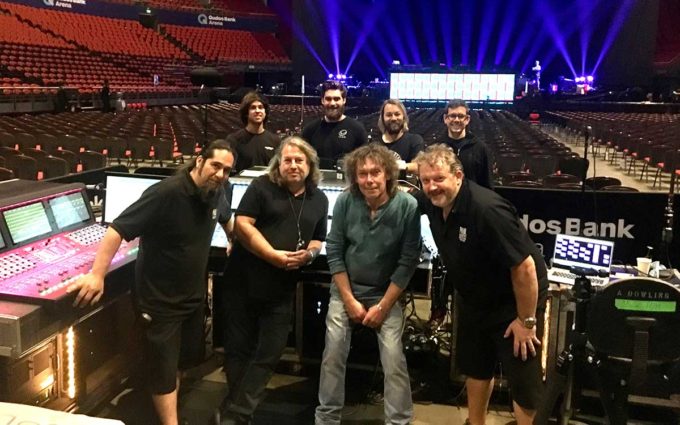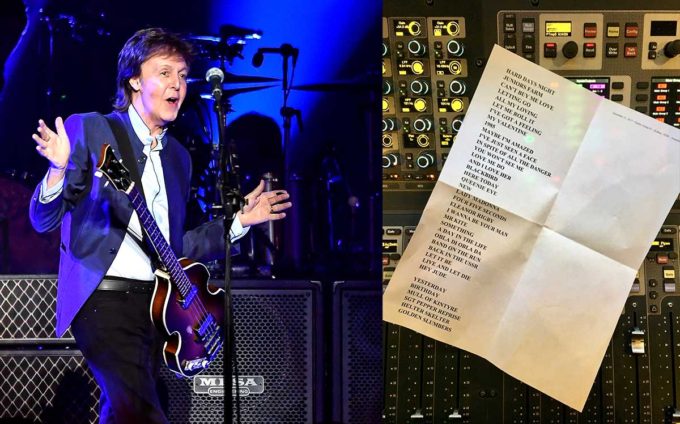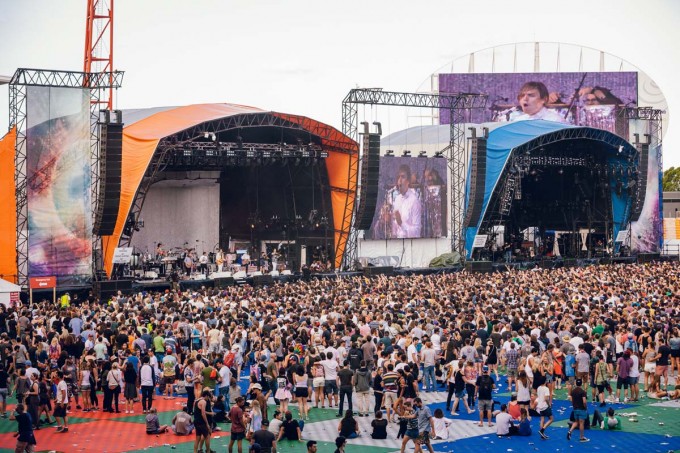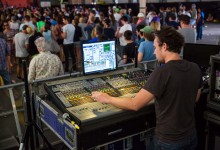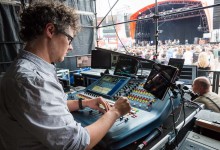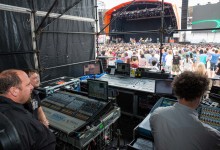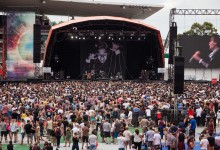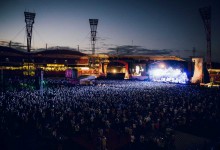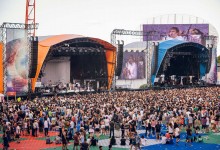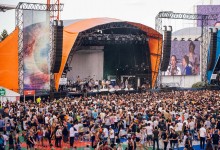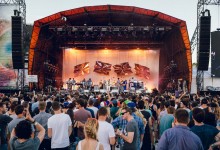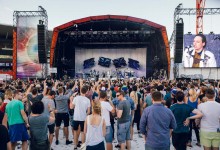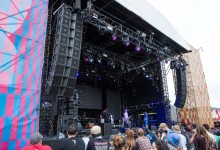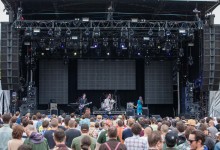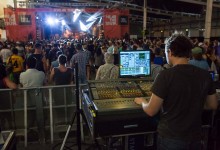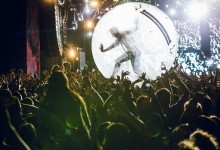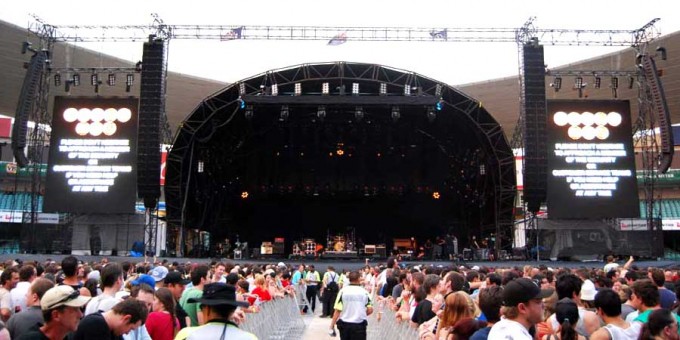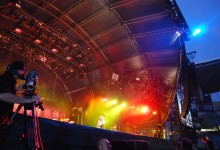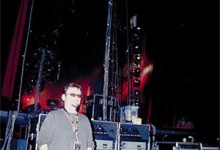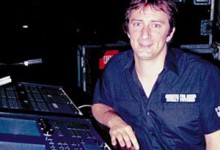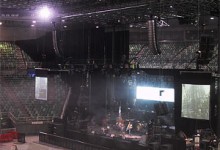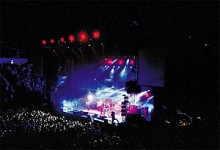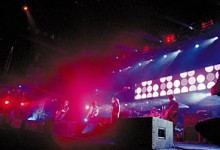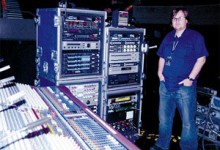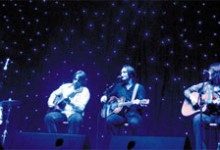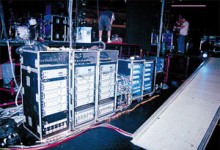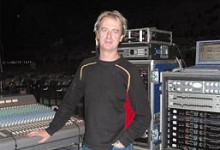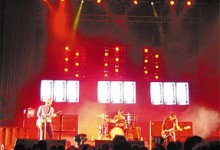Article courtesy of CX Magazine (May/June 2003 issue)
Silverchair approached Rolling Stones levels of interest and enthusiasm on their Australian Tour across autumn. The five week run was designed for theatre and stadium, and featured an Australian pragmatism that a forty year old band like the Strolling Bones could never achieve.
The parallels – guitar rock band; theatre AND stadium shows; fans who are welded on. The differences? About 150 people less on tour with the Chair. No physiotherapist, no personal chefs, no valets.
Production values were similar, and in proportion too. Where the Stones toured the largest LED video wall currently in use on the planet, the Chair toured the new Barco LED wall from Technical Direction Co – Australia’s largest and best new wall. The Rolling Stones had a new line array PA – the Chair had a modern NEXO Alpha PA system.
Patrick Woodroffe’s lighting design for the Stones had everything that moved, all controlled from a Hog II. Hugh Taranto’s design for Silverchair had more than enough in the way of fixtures – controlled from a Whole Hog III.
What I’m getting at, is that Production Values need to fit the scale of the show, and the Rolling Stones 14 truck tour is not that far removed from Silverchair’s two truck loads. The people who matter – the audience – were well satisfied in both cases.
I caught the tour at the Pallais Theatre and then two days later at the Vodafone Arena. The light and vision production was essentially the same in both venues, with less speaker boxes used for the 2000 Pallais than for the 6000 seat Arena. “It scales up nicely”, said the polite Hugh Taranto, veteran of many Silverchair tours. His lighting design was clever, because there was nothing flown in the grid that needed focusing, so no one needed to climb up there. That made a huge time saver, since the house worklights didn’t need to go out, and the safety issues of not having climbing crew are obvious.
“We can go up there (there is a ladder) and we have the rescue gear. But if we need to change something we usually lower the grid.” I have arrived at the Arena at 3pm, and Hugh is sitting arranging his cues. The load in was at 0800, so good time has been made. The stage set is loosely based on the Diaorma album cover, so rainbow colours and weird set pieces are used. Three LED video walls are flown at the rear quarter of the stage, hung intentionally crooked. Huge fake picture frames make them look kind of grunge-retro. Each wall is 5 panels wide and 3 tall, so they each measure about 4.5 x 2.5 metres.
Hugh operates the Whole Hog III, a wingboard, and three Catalysts – with 3 Mac G4 and 2 laptops. His FOH setup is complex, and hubbed together via an Ethernet switch. It is impressive to watch him work all this, alone, while calling two followspots. For the first half of the show, the three Silverchair members are joined by two guest keyboard players who are set on stage left, above and behind the backline. Coloured panels are over each backline speaker. Six ‘zip rings’ which are a circle of ten MR 16 lamps, are hung around the backline, giving Hugh another element to go with six Zip strips – sitting vertically around the stage, and gelled in rainbow hues.
The band take to the stage with pungent incense burning, plumes of smoke rising, and do a set of new material than builds to a break. Hugh has imagery generated from 3 Catalyst systems (with 3 Mac G4’s) feeding the three screens. The images combine moving black and white clips from band videos, and a smorgasbord of patterns generated on Catalyst. As the sole lighting operator, Hugh has control over outputting the images through the Hog III – making the show very harmonized.
“For the first half, the screens are set to 1000 nits. Then I turn them up (to 2000) for the second half. I’m using them more like lights them. They come in and flash, in colours, and are a big bright light.” Bright they are! The band wanted a quieter set with a different look for the first half. Behind the three oversized picture framed LED walls is a red drape. Lights play out a lot of looks, and two followspots very subtly fill out.
The second half is achieved after the crew reset the stage behind a curtain. The rear red drape is gone, revealing three pods of 24 Par 64’s, using 240v lamps so they can be chased in many combinations. Each is gelled.
A directive from the band is that the second half is not full of technology looks, so the moving lights are generally restricted to reset when dark, not moving while on. “It’s a traditional rock show – not the different world theme of the first half “, says Hugh. At the sound desk the two halves of the show are simply delineated by volume. The show grows louder as the night goes on. By the second half it is pumping fat, or phat as we call it in soundland.
This tour marks the first time that Melbourne sound engineer Bruce Johnston has mixed the band. The former Chair engineer took a gig in the USA, and the band had been looking to use Bruce for a while.
Bruce also owns a sound compact company – JAS – which means he was naturally keen to tender to supply equipment for the tour. He won. “I would use whatever they wanted to use, bar one kind of system that I have on my contract”. Bruce wouldn’t say which is the brand of system he dislikes, or why.
Bidding for the tour was intense, but Bruce’s system choice of Nexo won the contract. Owning it means the contract wasn’t awarded by Bruce in any case, the decision went back to management with recommendations from Baily Holloway, the crew boss.
60 Alpha boxes made up the rig, 24 M3 (mid/ high); 24 B1 (low) and 12 S2 subs were flown and floor stacked to cover the audience. These were powered by just 2 amp racks per side – each rack loaded with four Camco Vortex 6 ultra-high powered amplifiers. Each rack produced 24,000 watts for a system total of 96,000 watts.
For the first time, Bruce used all Nexo on one tour, as the monitor system was also Nexo branded. Rod Matheson generated 4 in ear, and eight equalized sends of stage monitors from a Midas XL 250 console. 14 Nexo PS15 wedges were used, along with 2 Alpha E full range boxes on each side of stage as sidefills.
Out at front of house, the mixing console was an ageing but still good PM 4000, which is the top of the line desk in the JAS inventory. “I’m buying a Midas XL4, because when everyone is busy they are hard to get”, Bruce explained, adding that it can cost $2,500 a week to cross hire one. Some changes arose with the Silverchair sound when Bruce started the tour with the band. Previously the band used almost all triggered drums, with as few as eight open microphones on stage. “The band’s drum kit was all electronic except the snare and overheads”, said Bruce. “We changed that! It’s more melodic now, the samples just didn’t cut it. There’s more light and shade in the kit (sound).”
“We cut a hole in the front of the kick (for a mic) and re-skinned the kit. We put a note on the song list for Ben (Drummer) to retune the snare after the third number.
The samples are still sent to the desk from the drum tech area, so there are a massive 16 drum channels. Only the snare is still mainly sampled, “the kit is 90% live now”, asserted Bruce. The almost vintage but still popular Yamaha SPX 990 features as a snare reverb, Bruce says he just can’t escape the 1980’s. With four guitar inputs, bass, and two keyboard players – one of whom has a Leslie (rotating) speaker box, the rest of the desk inputs are filled.
“He (Daniel Johns) is a soft singer, so I ride his gain. I got an Avalon tube preamp for his channel and noticed the difference from the PM4k input preamp straight away. There is shit for days, like ride (cymbal) and guitar that will come through the vocal mic.”
Bruce is referring to stage spill. This band has an enormous live rock guitar sound. Truly phat, creamy and about 420 horsepower. During the final part of the show, when the three core musicians are alone on stage, Silverchair are possibly the tightest hard rock band on the planet.
Dates
March 19, 22-23, 25, 28-29
April 1-2, 5-6, 8, 10-11, 13, 15, 17, 19, 20 2003
